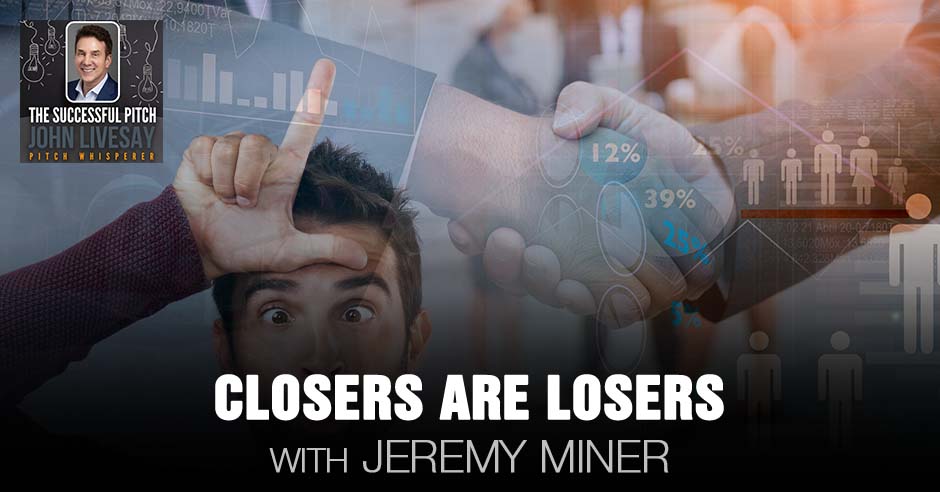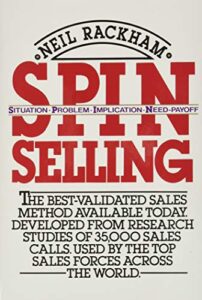Closers Are Losers With Jeremy Miner
Posted by John Livesay in podcast0 comments

Failing to close a deal as a salesperson is one of the most upsetting things that can happen to you. But what if I told you that it was actually your fault that you didn’t get the sale. Selling is about change and most salespeople sell the product, not what the product can do for the customer. Join John Livesay as he talks to Jeremy Miner about integrating human behavior into the sales process. Jeremy has been in sales for 7 years! He is the founder of 7th Level. He is the co-author of The New Model of Selling and is the host of the Closers are Losers podcast. Learn how human behavior affects your customer’s sales objections. Find out how to get people into your products with some of Jeremy’s modes of communication. Start closing all your deals today!
—
Listen to the podcast here
Closers Are Losers With Jeremy Miner
Our guest on the show is Jeremy Miner, who has a book out on selling. He said, “Be a problem solver, not a product pusher.” He talks about how objections are preventable. Finally, the whole premise of selling is about change and that you need to learn how to disarm people so that they are less resistant to it. Enjoy the episode.
—
Welcome to the show. Our guest is Jeremy Miner, who is Chairman of 7th Level, a global sales training company that was ranked very highly by Inc. Magazine. He is also a contributor to Inc. and has been featured in The Wall Street Journal, Forbes, and many others. He says this great quote, “The single most effective way to sell anything to anybody is to be a problem solver, not a product pusher.” For Jeremy, the embodiment of this philosophy has made him one of the world’s wealthiest sales professionals. Not just America, the whole planet.
In his sales career, he was recognized by Direct Selling Association. His earnings as a commission-only salesperson were in the multiple seven figures every year. Clearly, he is doing something right. He is the host of the podcast, Closers Are Losers. His new book, The New Model of Selling: Selling to an Unsellable Generation, is out now. Welcome, Jeremy.
My co-author there is Mr. Jerry Acuff, a good friend of mine. He is the CEO of Delta Point Consulting, a large sales training company on the East Coast. We wrote that together. It will be fun and games for the kiddos to read on the bookshelf. We are excited about it.
You are a big reader, but before we get into your passion for reading, take us back to your own story of origin. How did you get into the world of sales?
I was not born out of my mother’s womb with advanced questioning skills or tonality training. That is something that you have to acquire if you want to be great at what you do. I got into sales many years ago as a broke, burned-out college kid. I got my first job selling home security systems door-to-door. I was one of those guys you feel sorry for coming around in your door. I did not know what I was doing.
Eventually, when I knew what I was doing, do not feel sorry for me at that point. I was making a lot of money as a college student. I felt like I was Jeff Bezos. I was this little punk college kid. I got in. The company recruits everybody. It was a straight commission. They see who makes it. Most don’t. Eighty-nine percent do not make it. They give you a script, give you a couple of books by the sales gurus, take you out in the van, and drop you off in a neighborhood. Usually, a not so safe neighborhood
Hence, the need for security systems.
“Go make some sales, tiger. We will pick you up after dark.” That is pretty much what it was. I thought selling was going to be easy because that is what everybody in the office told me. I remember my sales manager saying, “When they open the door, be excited. Talk about how great the product is. People are going to love it.” I am like, “I will do that.” I was excited. I was telling about the features, the benefits, and all this great stuff that it was going to do, but I noticed that I started getting a lot of objections at every single door, “We cannot afford it. We do not need it. We already have somebody for that. Your price is too high. I have already talked with somebody else last year. I need to talk to my spouse. I need to think it over. Can you call me back in a week, a month, a year later?”
[bctt tweet=”Be a problem solver, not a product pusher.” username=”John_Livesay”]
I am like, “This is going to be harder than what I was told.” I remember about 7 or 8 weeks into all that rejection, barely making any sales. When you are paid straight commission, if you do not make any sales, you might as well work for minimum wage. You are going to make more money minimum wage. I remember one night in particular. I was standing on the curb. The sales manager was about to pick me up. If you have ever done door-to-door, you are walking around 10 or 12 hours, so your legs get tired. In the summer, you are sweating all the way down. I remember sitting there. I had not made any sales for the day. I had worked for twelve hours. That whole week, I had worked 60-plus hours and I made zero sales.
This is the end of the week. I had $0. I was newly married and I had a kid on the way. I barely turned 22. I was still in college. At that point, I felt broken. How am I going to go home and tell my wife at the time that we do not have enough money to pay rent? “We are going to have to move in with your parents and live in the basement.” That was going to be one of those. I thought that maybe selling was not for me. I remember that night, especially. When the manager picked me up, he plugged in a Tony Robbins CD.
This was back in the old days. I love Tony. Tony said something like this, “Most people fail for the simple reason, they do not learn the right skills that are necessary to succeed.” He went on to say that everybody is taught skills for the most part. He said, “People who fail are the ones who do not learn the right ones.” I am like, “Maybe I am not learning the right skills.” This light bulb went off like, “Maybe the company was training me and what I was learning from the gurus at the time, maybe they were not the right skills. Maybe they did not work very well anymore.”
I had this major dilemma because the company would give us all these books. They were teaching us that the most persuasive way to sell was here, but at the same time, I was in school. My degree was in Behavioral Science and Human Psychology. My professors and all the works I was reading were saying that the best way to persuade and communicate was on the other end. It was completely opposite of each other. The gurus were saying it was here. Behavioral Science and Psychology was saying it was on the other.
I am like, “What am I supposed to do? The theory with Behavioral Science and a bunch of other things with Psychology, how do I bring that into the sales process?” Once I started to do that and learn how to work with human behavior, instead of pushing like most salespeople, I learned how to get prospects to pull me in. Once I started to discover that way of communicating, selling became very easy and profitable. That is my boring background.

Closers Are Losers: Bring the theory of behavioral science and merge it into the sales process. Once you learn how to work with human behavior, instead of pushing like most salespeople, you’ll get prospects that’ll pull you in.
Is that connected to your methodology, the NEPQ?
That is where it started, Neuro-Emotional Persuasion Questioning. That methodology developed from my background in Behavioral Science and Human Psychology.
For those who are not familiar with Neuro-Linguistic Programming, most people are aware of what EQ is, but you have got the letters in a unique way. Can you tell us what that is and how somebody could start to use it?
It is much different than NLP. I like NLP. There are some things that are good in NLP, but typically, if you are using some of it in a one-to-one selling environment. It is not quite as effective, in my mind than selling one to many. It is a little bit different there. When I was in college studying Behavioral Science, it was broken down into three main categories. I am not going to give everybody the scientific terms. I am going to give you something that everybody would know on here.
Sales and communications are broken down into three forms. All of you reading this right now, once you understand where you are in these three forms, where your current sales ability is compared to where it could be, it will completely change everything for you. I do not care if you are already making $10,000, $15,000 or $20,000 a month. There are ways you can make a lot more selling the exact product or service you are now. The first mode of communication, we would call this arrow one type of sales. Think boiler room selling. What is the first image that comes to your mind when I say boiler room selling?
[bctt tweet=”Most people fail for the simple reason that they don’t learn the right skills that are necessary to succeed. ” username=”John_Livesay”]
That movie and they are all, “Coffee is for closers.”
We are the least persuasive when we tell people things or we attempt to dominate them, posture them, manipulate them or push them into doing something we want to. As you said, Wolf of Wall Street. I am assuming Jordan Belfort. They portray him that way. I do not know if he was that way. That is how he is portrayed in Hollywood. Who knows? He is like, “I have got a great opportunity for you.” We talk about the features and benefits of what we do. We push them, tell them why they need to buy, and why we are the best. It is like telling your spouse that they need to do something for you and then you keep pushing them. What do they typically do back? They push back. It is human behavior 101.
If you push, people resist more. Most of the time, they push back. I will give you a few examples of the least persuasive way to sell because so many salespeople are still taught this way. Presenting. We are all taught that you have to have a great presentation. We have to show them how great our services and products are. We have to have an hour and a half pitch deck. We have got the best this. We have got the best that. Does not every single salesperson say that they have the best product and service? It is like watching The Bachelor. I do not know if you have watched The Bachelor, but they come out the host every year. They say, “This is the most dramatic Bachelor of all time.”
I am like, “You said that last year and the year before and the year before.” You stop believing it after a while. There is not going to be any salesperson who will say, “John, our service is fifth-best in the market.” Everybody says they are the best. When we hear things like that as a consumer, it goes in one ear out the other. We do not trust that. We trust people less when they say things like that or they talk down their competitors because we are used to everybody doing it.
According to the data, it is not very persuasive if your presentation is more than 10% of your entire sales process and/or conversation. The average salesperson is about 50%. That is a massive problem. “Telling is not selling.” We have all heard that saying. Telling your story is important like we talked about when I was on your show, but it has to be a structured story, not a winged story that does not have any relevance in a sales pitch. We have all been taught that we have got to give a great pitch.

Closers Are Losers: Sales and communications are broken down in three forms. And, once you understand where you currently are in these forms, everything will change for you.
According to the science, it is not a very persuasive way to do it. It is how you pitch. Do you ever watch Shark Tank on CNBC? When the entrepreneurs come out, they are excited. They are going to pitch the sharks. Watch the body language of Mark Cuban, Barbara, Mr. Wonderful, Kevin, and Daymond John. It is because of the way they are presenting that.
The big one is assuming the sale. According to the data, very low on the persuasion poll, especially if you are more of a complex selling environment that requires multiple calls and touches. I think me and you talked about that. That is the first form. The second form of communication, I will boil that down to this. I will call it consultative selling. Everybody knows what that is. We are more persuasive when we attempt to have a real discussion with the prospect.
Consultative selling, for the most part, would be known in books like SPIN Selling by Neil Rackham. The professor that came out in the mid-’80s taught that you need to ask logical based questions to find out the client’s needs. What is a potential downfall of the approach when you are only asking logical-based questions? We call those surface-level questions.
The prospect is going to give you logical-based answers in return. As you and I talked about, do people buy on emotion or logic? One hundred percent on emotion. Brain studies show that. We are more persuasive than boiler room selling, manipulating, and trying to pressure them, but you are still going to play the numbers game because you are not bringing up very much emotion by asking the same old questions. “John, what is keeping you awake at night?”
You cannot use those types of classic questions because your prospect hears them all the time or, “Who, besides you, would be involved in the decision?” It is boring surface level. Instead, re-language that. You can say this, “Sally, can you walk me through your company’s decision-making process to solve challenges like this? Walk me through.”
[bctt tweet=”It’s not very persuasive if your presentation is more than 10% of your entire sales process. Telling is not selling.” username=”John_Livesay”]
She is going to start thinking in her mind about what the decision-making process is. It causes their brain to go in a different range. The third mode of communication, everyone might know as dialogue. That is arrow three. We are the most persuasive when we allow others to persuade themselves. That is where we come in with Neuro-Emotional Persuasion Questioning. The key is where we ask certain questions and techniques that work with human behavior that get that prospect to want to open up, to want to engage and pull us in rather than us push them forward.
That is the question that everybody asks me, “How do I get somebody to persuade themselves? Can I show up and say, “Mr. Prospect, persuade yourself? By the way, here are the wiring details.” No. You have to learn the right questions to ask at the right time in a structured situation. We talked about storytelling as a structured process that gets the prospect to sell themselves and pull you in. Those are the three.
Do you think that the main reason there is such a delay and people’s sales cycles keep getting longer and longer is that everyone’s got a different reason for making a decision? What are some questions that people can ask to create some urgency?
I am always brutal in telling people what I think. When we go in and do audits with companies, it is all the same. Buying decisions only stall for the most part because sales teams are still being taught sales techniques that work against human behavior that trigger sales resistance and create uncertainty and doubt in your prospect’s mind. When your prospects have doubt and uncertainty, what are they going to do? They put on the brakes because they are uncertain. That is triggered by what we are saying and/or not asking.
I had somebody ask me at an event one time, “If you could describe selling in one word, what would that be?” It took me a few seconds and I am like, “It would be change.” That’s all that selling is. It is how good you are at getting your prospect to view, in their mind, that by changing their situation, that means purchasing your product, service, or whatever your solution is. By them doing that, that is far less risky for them than doing nothing at all. Staying in the status quo, the problem stays the same and nothing ever changes, which is more risky for them.

Closers Are Losers: You have to realize as a sales professional or as a business owner, you’re not selling the thing. Instead, you have to sell them the results of what that thing does for them.
Whether you want something better or the prospect is trying to get away from pain, it is about change. If selling is about change, here is your massive problem. Human beings do not like change. Selling is all about change, but human beings, the way we are wired, we do not like change even though we say we do. Why do we not like it? We feel unsettled. We feel a bit uncomfortable, especially when it is initiated by some pushy salesperson that is ready to pitch us in the first twenty seconds of a conversation.
Human behavior shows that we value something that is more known to us or something that is more consistent in our lives over something that is unknown. Think the battered spouse syndrome. The spouse keeps coming back and we are like, “Why do they keep coming back?” It’s because they fear the unknown over coming back to what they know even though they do not like it. Isn’t that crazy?
A lot of people are like, “Why does the wife or husband keep coming back for the verbal abuse?” You are like, “They fear the unknown, even over something that they hate.” We have to realize as a sales professional or as a business owner, you are not selling the thing. We have companies that come in and they are like, “I am in HVAC. I am competing on price because they can get the same HVAC XYZ system.” I am like, “Stop. All you are talking about is selling them the thing. You have to sell them the results of what that thing does for them. That is what you are selling.”
If you are a real estate agent, you are not selling them a home. You are selling them the results of that home and what that home will do for them. Maybe it is to get them out of a bad neighborhood into a safer neighborhood. If it is a multimillion-dollar home, you are selling them on the thing on that home that is going to give them the status in their brain to fulfill an emotional need. If you sell an insurance policy, you are not selling them a policy. You are selling them financial protection when the spouse passes away and the other spouse does not have to worry financially. That is what you are selling.
If you are selling cyber security to Wells Fargo, you are not selling the software. You are selling the results of what that does, which is going to protect their customers from fraud. We have to start thinking, “We are not selling the thing. We are selling the results of what that thing does.” You asked me a few good questions. One thing that we can do is, let’s say, we get through a first call of discovery call. Let’s say you sell B2B. You are talking to a company. Your next step would be to schedule a demo. Before you do that, let’s say you are three-fourths of the way in that conversation. You have helped them find out what their situation is. We call that their current state.
[bctt tweet=”Selling is change.” username=”John_Livesay”]
You have also found out where they want to be. We call that their objective state, like what their future looks like. What is the gap between all these problems your questions have allowed them to see and did not know they had? What I want to do is when they see what their future looks like, and they start to feel what it is going to feel like once all these problems are solved, we want to rip that feeling away from them where they emotionally have to defend themselves on why they have to change now, not later. When you start to become good at this, you hardly ever get, “We need to keep looking around. I want to think this through.” That is a trigger response.
I might ask them, “What are the possible ramifications if your company does not do anything about solving this and it keeps getting worse? What happens to you guys, then? Have you thought about what would happen if your company does not do anything about this?” Those are generic consequence questions. Whatever you sell, you would supply that in. Let’s say I sold lead generation. I am selling leads to like SMB companies that need a higher quality lead. Let’s say their problem is their salespeople are speaking to lower quality leads, they are overspending on leads, leads are stagnating, and they keep going down.
I might say something like this, “Hold on. What happens if you guys do not do anything about this? You keep getting these lower quality leads to your sales teams and your sales keep stagnating another 3, 6, even 12 months from now. What happens at that point?” That gets them to think of the consequences of what happens if they do not do anything about solving that problem now.
You started your story about talking about all the objections you got when you were doing door-to-door. You also say that there is a way to overcome objections and prevent them from ever happening.
I think people think I am crazy when I say that. They are like, “What? How do you prevent objections from happening in their mind?” It is easy. I would rather focus on preventing objections from happening and have way more laid out sales. I am assuming you are the same way, John. That is why you have structured stories because here is the thing. I am always like, “Where is the science behind where that came from? That guy is an ass.”

Closers Are Losers: Most sales objections are triggered by you, the salesperson in what you’re saying. You’re triggering uncertainty and doubt in their mind. So instead of saying “sign the contract”, say “authorize the agreement”.
When sales trainers say, “The more objections you get, the more interested they are.” What study shows that? The more objections you get, the less likely they are going to buy. If that was the case, you would not have any lay-down sales. What about the lay-down sales that had zero objections? Where does that come in? It does not make any sense.
I want to prevent the objections from happening. If they do, I know how to handle them. We call that objection prevention. Salespeople do not like it when I say this. Most objections are triggered by you, the salesperson and what you are saying. Not asking is triggering uncertainty and doubt in their mind. A lot of salespeople, and I still cannot believe they are still saying this, but they will be like, “John, I need you to go ahead and sign the contract.”
Sign and contract are two words that typically trigger sales resistance in a lot of people because no one wants to sign a contract that walks them into something they might not want down the road. If I make that languaging more neutral, I do not trigger that. If I say, “John, the next step is to authorize the agreement.” It means the same exact thing. Sign the contract, but if I say, “Authorize the agreement,” it is the same thing, but it is far more neutral.
With this concept of getting in our own way, as a sales keynote speaker, I find that audiences do not take responsibility for the reaction they get from someone. If you show some empathy and anticipate an objection, keeping in mind that most people are wondering, “Will this work for me?” If you say, “You might be wondering now if this is going to work for you,” and then you give them an answer, you have shot that objection down before they even say it.
It is exactly that. We train a lot of car dealerships too, and retail stores. What does every salesperson do when somebody walks into the store? “How can I help you?” What type of reaction did they get 95% of the time?
[bctt tweet=”Buying decisions only stall because sales teams are still being taught sales techniques that work against human behavior. ” username=”John_Livesay”]
“No, thanks. I am just looking.”
If you already know that you are going to get that, do not say, “How can I help you?” You are going to cut that objection off like you did on that stage. What you did is brilliant. You simply go into the objection and say, “Thanks for coming into the dealership today. Are you guys out looking around?” They are like, “Yes.” They say, “Do you know what you are looking for?” You are right into the conversation. It is their objection. They cannot say, “I am looking around now.” I just said, “Are you guys out looking around today?” “Yes. For sure.” “Do you know what you are looking for?” You are right into it. It is so simple. What you did there was brilliant on stage.
Let’s talk about closing. This concept of ABC, we joked about it a little bit with the boiler room mindset. I have replaced that with ABK, Always Be Kind, in the way you talk to yourself and other people because you cannot give that out. What is your alternative to the old way of Always Be Closing?
We use the ABDs. Always Be Disarming. What do I mean by disarming? Throughout all of that presentation, you do the same thing when you are on stage, John. You are disarming throughout the whole presentation. You know what objections the audience has. You know how to prevent them from the beginning of what you say on stage, all the way to the end. You are continually telling stories to disarm them to become open to what you are offering at the end. That is all you are doing.
If you are in a one-on-one sales situation, whether you sell business-to-business or business-to-consumer, your ultimate goal is to get that person to purchase what you are offering to solve their problems. You are doing them a favor by paying you to solve their problems. You have to look at yourself as that salesperson that does that.
You are continually asking the right questions in that process that continually disarms the prospect where they want to keep engaging and opening up to you. One good way to do that is if you have somebody that is closed off, let’s say that you finally weed your way throughout the organization of the company. You are selling to a Fortune 1000 company. You are talking to the division head, the main person. That is your sixth appointment. You have finally figured out how to get through.
Let’s say that person is hard as nails. They do not want to open up to any of your questions. You are going to stop that conversation halfway through. Let’s say you are on Zoom or even in person, you can lean in and say, “Me and you here, off the record, what is holding you back from being able to X, Y, and Z?”
You cannot do that in the first ten seconds because there is no trust. You cannot force your way into that conversation. You know they are not opening up. They are staying surface level with you. You simply stop. You lean in and say, “Between me and you, off the record.” People open up. You do not use it every time. You’ve got to know when to use it. You cannot use it in the first two minutes because there is no trust throughout that conversation. That is a way to disarm a prospect to get them to open up.
We have gone full circle because you talk about selling is all about change. You are disarming people. You are mitigating the risk to do that change. That is a great summary of your skillset and the training you offer and your new book that is co-authored. It is going to be something that people are going to want to run and get The New Model of Selling: Selling to an Unsellable Generation. If people want to reach you, Jeremy, where should they go?
If they want to learn about what we do or even get some free resources from us, they can join one of our free Facebook groups. Send them to www.SalesRevolution.pro. We got about 18,000 C-level executives, salespeople, and entrepreneurs in there that want to get better and sell. Right when they join, check your Facebook Messenger because somebody on my team will message you over a free training called the NEPQ 101 Mini-Course. It is with my CEO, Matt.
Matt will break down different questions that you can use for different sales situations we know that you are going to be in on a day-to-day basis that will help you sell more. We go live in that Facebook group 3 or 4 times a week with different Q&As and different trainings for B2C and B2B. They are welcome to join that if they want to get some sources to sell more.
Thank you so much for telling us about your own story of origin and how you have learned to be prepared and even prevent objections and closing by making people feel safe to open up with, “This is off the record.” Thanks again, Jeremy.
Thanks, John, for having me on.
Important Links
- Jeremy Miner
- 7th Level
- Closers Are Losers
- SPIN Selling
- www.SalesRevolution.pro
- https://SalesTraining.ClickFunnels.com/optin164548828699
- Better Selling Through Storytelling Method Online Course
Wanna Host Your Own Podcast?
Click here to see how my friends at Podetize can help
Purchase John’s new book
John Livesay, The Pitch Whisperer
Share The Show
Did you enjoy the show? I’d love it if you subscribed today and left us a 5-star review!
- Click this link
- Click on the ‘Subscribe’ button below the artwork
- Go to the ‘Ratings and Reviews’ section
- Click on ‘Write a Review’
Love the show? Subscribe, rate, review, and share!
Join The Successful Pitch community today:
- JohnLivesay.com
- John Livesay Facebook
- John Livesay Twitter
- John Livesay LinkedIn
- John Livesay YouTube
Tags: Communication, Consultative Selling, Dialogue, human behavior, Sales Resistance, selling

